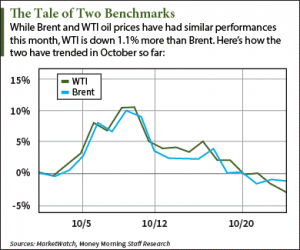 WTI crude oil prices today (Tuesday) dipped 1.4% as the U.S. benchmark falls deeper into a two-week slump.
WTI crude oil prices today (Tuesday) dipped 1.4% as the U.S. benchmark falls deeper into a two-week slump.
At 8:30 a.m., WTI crude oil prices today were trading at $43.38 a barrel. Yesterday, the U.S. benchmark closed at $43.98 – the lowest settlement since Aug. 27. Futures are down 4.8% in October.
Meanwhile, Brent crude oil prices were down 0.6% to $47.24 a barrel today. Futures for the global benchmark have fallen 6.4% since Oct. 16. They’re down 3.7% so far this month.
The decline in WTI crude oil prices today comes before the start of the U.S. Federal Reserve meeting. Traders are focusing on whether or not the FOMC will raise interest rates in 2015. An interest rate hike would strengthen the dollar and make dollar-denominated commodities like oil more expensive to other countries.
However, analysts say the Fed will likely hold off on a rate hike due to recent market volatility. After all, the Dow Jones Industrial Average is down 2.3% over the last six months.
But oil investors are more worried about Iran. The market has been anticipating the return of Iranian oil ever since the nuclear deal was struck, allowing the country to ramp up oil exports.
“In short term, the bearish momentum seems to be building up as prices slowly inch downward,” said Daniel Ang, energy analyst at Phillip Futures, to MarketWatch. “At the end of the day, we would think that as we draw nearer toward November, the idea of Iranian oil coming back could still be putting a stop to any bullish momentum.”
Investors worry Iran will flood the oversupplied market with more crude and send prices to new lows. With WTI crude oil prices in the $40 range, some think Iranian exports could be the breaking point that crashes the oil market.
But Money Morning Global Energy Strategist Dr. Kent Moors says Iranian oil won’t have the negative impact investors are worried about…
How the Iran Nuclear Deal Will Affect WTI Crude Oil Prices
According to Moors, Iranian oil won't hit the market for at least 18 months. By that time, prices will have fully stabilized.
[mmpazkzone name="in-story" network="9794" site="307044" id="137008" type="4"]
You see, a report by the Associated Press back in August said Iran will be using its own experts to inspect Parchin – the country’s most suspicious testing facility. Parchin has been tied to nuclear weapon testing more conclusively than any other site in the country. The facility is where nuclear bomb detonators have been tested for more than a decade.
But even if Iran conducts its own inspections of Parchin, there are a dozen other sites requiring inspection by the International Atomic Energy Agency (IAEA). These UN-sanctioned checkups will ensure Iran is abiding by the deal and scaling back its nuclear research.
Iran stubbornly disagrees with the inspections. The country has publicly said IAEA inspectors are spies working for Iran's enemies.
That hardened attitude will result in delayed inspections and – in turn – delayed oil exports…
“It’s all in the hands of the West,” Moors noted. “There will certainly be benchmark requirements in place that Iran will have to meet and verify before any oil is exported. So the relaxing of sanctions will occur over time.”
Depending on Iran’s cooperation, it could take even longer than 18 months to start exporting oil. That gives oil prices plenty of time to return to normal levels.
Alex McGuire is an associate editor for Money Morning who writes about energy. Follow him on Twitter for the latest oil and gas updates.
The Iran Nuclear Deal Is Far from Over: Although it was reached on July 14, the Iran nuclear deal still faces several hurdles that could prevent it from ever going into effect. Here’s a timeline showing how the deal will play out over the next 15 years…


